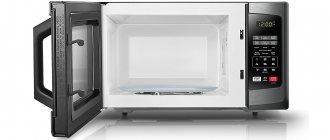Compatibility
The functions performed by the refrigeration unit and the oven are diametrically opposed, which is why it seems that it is impossible to place a microwave on a refrigerator. But this apparent contradiction is not true, since both devices are isolated from the external environment and perform their functions in a closed internal space.
Proof of the peaceful coexistence of a microwave and a refrigerator are reviews from users who have had them peacefully coexist for several years. Therefore, you can put a microwave on a refrigerator, but subject to certain conditions.
This is interesting: Which drum for a washing machine is better: stainless steel or plastic?
Reviews
In general, numerous consumer reviews indicate that you can place a microwave oven on top of the refrigerator; this is a fairly common occurrence. Many people say that in their families the microwave has been standing like this for a very long time, for many years.
Both devices are in good working order and work flawlessly. There are no side effects or operational irregularities observed . It's easy to explain. Each of the devices has powerful insulation, which is the main requirement for their effective operation.
Otherwise, the refrigerator would not be able to work, for example, in hot summers. A microwave oven is designed in such a way that the propagation of microwaves outside the housing is prevented.
And we know that nothing around the device ever melts and surrounding objects do not heat up. This means that there cannot be contact between these two devices even with such a close location.
And consumers confirm this with their examples.
From the following video you will find out whether it is possible to place a microwave on a refrigerator.
What is written in the instructions
The operating rules of most manufacturers do not provide for the possibility of installing one device on another. The instructions do not say anything about this, but the risks associated with such an arrangement must be taken by the owner of the devices .
The microwave overloads the refrigerator's compressor, causing it to use more electricity. The compartments become warmer, and the engine may wear out prematurely and fail.
If the fact that the microwave oven and refrigerator are adjacent is known to the service department, warranty repairs will most likely be denied. But these actions are illegal if the instructions do not directly prohibit them.
You can minimize the impact of microwaves on the refrigeration chamber by following the rules for its installation. In this case, the devices can work for years without breaking.
In what cases can an exception be made?
Placing a microwave oven on the refrigerator body is allowed in the following cases:
- The microwave is used occasionally and no longer than 5-7 minutes in a row. In this case, the equipment and the air around it will not overheat.
- It is possible to ensure normal ventilation of devices. Preference should be given to stove models with ventilation holes on the side or at the top.
- Unhindered access to the microwave will be provided .
To save space, you can purchase a built-in microwave. It is easy to hide behind the facade of the kitchen unit.
Is it possible to microwave
Let's consider situations in which it is or is not possible to place a microwave oven on or next to a refrigerator.
On the refrigerator
The conclusion is that you cannot place a microwave on top of the refrigerator. But, there are a number of points in which such placement is acceptable:
- if the microwave oven is used only for defrosting or heating food. That is, it will work no longer than 5 – 7 minutes. Longer operation is unacceptable, as the body of the equipment will begin to heat up, which will negatively affect the refrigeration equipment;
- if ventilation gaps are observed. Namely, there should be a distance of at least 20 cm from the microwave to the ceiling. This is feasible if the refrigerator has a height of 90 - 120 cm;
- if there are ventilation holes at the bottom of the microwave. In this case, a gap of at least 1 cm is left between the equipment. To level out thermal loads, a protective substrate is placed under the microwave oven. A sheet of chipboard, OSB or plywood is suitable as a thermal insulation material;
- when both household appliances are grounded;
- Each type of equipment is connected to a separate outlet. The fact is that the microwave and refrigerator separately consume considerable power, and one source may not be enough for two.
As they write in the reviews, such placement, taking into account all the requirements, extremely rarely causes a breakdown.
Next to the refrigerator
Even if there is no free space on the refrigerator, consider installing it nearby. This accommodation option is considered convenient and safe. In this case, each device must be grounded and have enough “freedom” for unobstructed ventilation.
It is better to place the microwave and oven next to each other
The microwave oven must not be placed near sources of water and heat: ovens, sinks, radiators, and so on.
There are arguments against the “neighborhood” of a refrigerator with a microwave. Among them: short circuit and network overload. This will not happen if you isolate the metal parts of the cases from each other and connect the equipment to different sockets.
There is another opinion - a working refrigerator and microwave add up their own radiation, which negatively affects health.
This is more of a far-fetched fact, since the refrigerator has extremely low radiation, and microwave microwaves only affect the working chamber of the oven.
To the freezer
The same rules apply here as in the case of installation on a refrigerator. Such placement is allowed, but only if the microwave will be used only for heating or defrosting food.
Cooking food requires more power, which leads to heating, and this will affect the operation of the freezer. As a result, you can install it, but with restrictions.
Specifics of the device operation
The main thing when placing a microwave oven is to take into account the specifics of its operation. This device emits strong electromagnetic waves around itself. Modern ovens have high-quality screens that block these waves. But some of the radiation still reaches the surface. Therefore, the devices should not be placed near plants or animal cages - the radiation will negatively affect them.
Some models of microwave ovens have ventilation holes on all sides, even at the bottom.
Radiation can damage gas meters, so when using them, the stove must be placed at a distance.
The effect of radiation on people should also be taken into account. It is important not to install the device near places where people spend a long time or where children like to play.
Posting rules
To ensure normal operation of the devices in question, it is necessary to ensure:
Reliable ventilation . Most microwaves have ventilation holes located not only on the sides and back, but also on the bottom. Therefore, for effective ventilation, care should be taken to purchase legs, since without them the stove may overheat and subsequently fail. The stove must be installed on a stand made of solid heat-insulating material, such as plywood. The use of paper, oilcloth, and plastic film is unacceptable. The distance between the microwave and the wall should be at least 12 cm, and at least 20 cm to the ceiling.
Ease of use . If the height of the refrigerator is more than 2 m, it does not make sense to install a microwave oven on it, since it will be difficult to put food in and take it out. And hot liquid dishes can inadvertently scald you.
In apartments with low ceilings, with such placement it is impossible to maintain the 20-centimeter gap between the stove and the ceiling necessary for ventilation. But the biggest troubles will happen when it collapses due to the vibration of the refrigerator during operation from such a height, and even when it is turned on.
According to standards, the distance from the floor to the microwave should be at least 90 cm and no higher than 150 cm. It is optimal to place it at a height of approximately 7 - 10 cm below the hostess’s shoulder. This is the safest height.
Furnace usage intensity . If the microwave oven is intended to be used only for defrosting food and heating ready-made dishes, then there are no obstacles to placing it on the refrigerator, since it does not operate for long in these modes. However, when cooking, the oven operates for a long time, releasing a large amount of hot air, which disrupts the normal cooling of the refrigerator condenser. As a result, the freezing properties are impaired and the load on the compressor increases. This leads to increased energy consumption and reduced service life. Therefore, in this case, the microwave should be placed further away, since even next to the refrigerator it will negatively affect its operation.
Protection against electric shock . According to the instructions for use, the microwave oven must be grounded. Since it can touch the refrigerator, both devices must be provided with special plugs and sockets for reliable connection to grounding, made in accordance with the rules for the safe operation of electrical installations.
You should know that a microwave on a refrigerator gives repair services a reason to refuse warranty repairs for both devices.
Safety in use
In order for the device to serve for a long time and bring only benefits to its owners, it is necessary to comply with basic safety requirements. In addition to the installation rules described above, it is important to observe connection security.
Due to the fact that the microwave is a heating device, and the refrigerator is a cooling device, there must be a high-quality thermal insulation layer between them.
Since this device is quite powerful and its connection requires grounding, it must be plugged into a separate outlet. It is prohibited to connect a microwave oven to the same electrical outlet together with other powerful devices: refrigerator, kettle, convection oven, multicooker. This can lead to overload of wires, short circuit and, as a result, fire.
You cannot place anything under a microwave oven: paper, cellophane, etc. can get hot.
And of course, under no circumstances should you plug into the network a faulty device that works strangely.
If you follow the basic requirements for use, the microwave oven will bring only pleasure and joy to the family and will last a long time.
The microwave can be safely placed on a low refrigerator, it is convenient and can be easily reached.
This is interesting: Which is better, a multicooker or an air fryer: features of operation and choice
Helpful tips for proper installation
There are several simple recommendations that will help avoid damage to the unit and extend its service life:
- When installing the device, you need to provide a separate outlet for it.
- You should not place the device near indoor plants, as electromagnetic radiation will have a detrimental effect on the plants.
- It is not advisable to turn on the microwave oven and the device on which it is located at the same time.
- The device must not be placed near gas meters to avoid incorrect operation of the latter.
- Installation above a sink, on a high refrigerator, or on a gas stove is strictly prohibited. It is advisable that the TV, if there is one in the kitchen, be placed high under the ceiling on special brackets.
- If there is a gas boiler nearby, it should be a closed type.
Placing a microwave oven on a refrigerator or near the unit is permitted.
However, in this case, you need to ensure the correct installation of the device, which provides for the optimal installation height, the absence of vibrations, splashes of water, and heating devices nearby.
Tips for choosing a location for your microwave
Following the recommendations in the instructions supplied with the microwave oven, it should be grounded to avoid electric shock. At the same time, if it was decided to place the stove on the refrigerator, you will have to ground both devices.
Where is it better to install a microwave and why?
When installing a microwave oven of any model and brand, you should adhere to the following installation rules:
- Ideally, place it on a flat and stable surface while maintaining air access to its ventilation;
- It is better to install away from heating appliances and other household appliances that can produce heat;
- Do not cover the stove with objects from its surroundings. The distance between them should be at least 10 centimeters;
- Maintain a free space of at least 30 centimeters above the oven top cover.
- For simplicity and convenience of placing a microwave oven in the kitchen, you can use special brackets that allow you to mount it on the wall. In addition, when choosing a place for the microwave, you should remember not only about comfortable cooking, but also about how you will wash it.
It is quite acceptable to install a microwave on a windowsill, the main thing is that its dimensions not only allow this, but also ensure proper ventilation. At the same time, it should be taken into account that the warm air emanating from the microwave during the cold season can lead to the accumulation of condensation on the glass.
When installing the stove on the table, we must not forget that there are always dishes and other kitchen utensils on it, which will not only create difficulties in its operation, but will also in some way block its ventilation.
Don’t forget about the aesthetic side of the issue - the microwave should fit organically into the interior of the kitchen and be easy to use.
Where is it not recommended to place a microwave oven and why?
- Regardless of the chosen stove model, due to the heat it generates during operation, it should not be installed in closed, unventilated niches;
- Do not place the stove in close proximity to appliances that generate heat;
- It is forbidden to place it in close proximity to a water supply, since water entering its body can lead to a short circuit and its complete failure.
Launching a new device
- It is recommended to thoroughly wipe the new device with a damp sponge.
- Eliminate all possible defects of the device inside and outside the chamber, including on the door.
- It is imperative to maintain ventilation, namely to allow 10 cm between the walls of the microwave and other objects, including the wall.
- Make sure the roller stand and turntable are in good condition.
The microwave must be plugged into an outlet with a current of 15 A. Do not place the microwave oven in places with high temperatures - a stove or radiator. Access to the device should be unobstructed and at a sufficient height, especially if there are small children in the house.
Where is the best place to put a microwave oven?
There are several options, each with its own advantages and disadvantages. Often the microwave is “hidden” under the countertop. This way it will not take up free space on the work surface.
One of the kitchen cabinets is being replaced with a niche for a microwave. But for tall people it will be inconvenient. Moreover, it is better to abandon such a decision if there are small children living at home, who are curious and omnipresent.
Another installation option is on a countertop. The advantages are as follows:
- quick access (“at hand”);
- comfortable height;
- there is a work surface nearby;
- it is more convenient to monitor cleanliness;
- the entire body of equipment before your eyes. This makes it easier to identify even minor faults;
- If desired, it can be easily rearranged to another place.
This is the best option, but only for spacious kitchens. Otherwise, the microwave will “eat up” a considerable share of free space, which is already in short supply. Often the installation location is a corner, which is also convenient.
If it is not possible to “hide” the microwave in the set, it is installed on a separate shelf.
Safety rules play a special role here. If the walls are made of plasterboard, they simply will not support the weight of the equipment. Often, a microwave oven is placed on brackets attached to a concrete or brick wall. The advantages are the same as when installed on a shelf.
Posting rules
A microwave oven can operate for a long time only if you adhere to the following rules:
- the stove must be placed on a reliable, stable stand;
- the minimum distance from the floor is 90 cm, the maximum is 150 cm. Even higher is allowed, but getting food out will simply be inconvenient;
- It is prohibited to place equipment near heat sources (batteries, heaters);
- ventilation openings must be open at all times;
- a thermal insulation pad is placed under the stove, which will absorb heat flows;
- The microwave should not touch its bottom to the work surface. Therefore, it is better to choose models with adjustable legs.
The option of installing a microwave on a refrigerator worries many. This will save free space, but other difficulties arise. Is it worth it or not - everyone decides for himself.
Safety precautions
If the microwave is on the refrigerator, you need to take into account the features of its operation:
- Outlets must be grounded. Due to fire safety requirements, one socket cannot be used for two devices, even through an adapter. Otherwise, the network will be overloaded.
- You need to make sure that the wires do not come into contact with the back wall of the refrigerator. It does not matter whether the unit is equipped with a know frost system.
- There should be no water sources nearby.
- Do not install the microwave near heating devices.
To use the microwave safely, it must stand firmly on the surface of the refrigerator body.
Rules for installing a microwave oven
Follow these guidelines when installing your microwave oven to ensure long, safe operation:
- Before installation, wash the device with a soft cloth or sponge soaked in warm water.
- Remove the protective films from the case, assemble the rotating table, if provided for by the design.
- Make sure that there are no electrical appliances that are too hot nearby: heating radiators, ovens, stoves, etc.
- Avoid proximity of the stove to a water source and water heaters.
Why not: moisture, splashes and drops of water can disrupt the functionality of the device and even cause a short circuit.
- Remember that microwave waves can interfere with the operation of other household appliances, so move vulnerable appliances away.
Now you are aware of the compatibility of two electrical appliances: a refrigerator and a microwave oven. If the specified rules are observed, this neighborhood is quite acceptable.
Consumer Opinion
To understand whether it is rational to place a microwave on a refrigerator, it is worth studying user reviews. People have different opinions on this matter. Some believe that appliances stacked on top of each other spoil the interior of the kitchen. In addition, to use it, a child or short person may need to stand on a chair, which is unsafe.
Others argue that baking on the refrigerator is the best option. Small children cannot reach it , so they cannot experiment with heating spoons and other inappropriate objects. And if the room is small, there may not be another place for the device.
Myths about friendship and hatred
The proximity of a microwave to a refrigerator often gives rise to a large number of rumors and gossip, which is why the answer to the question about the proximity of a microwave to a refrigerator should be a categorical “no.” Most often, these rumors are not confirmed by anything, but we will get acquainted with them anyway.
Myth No. 1. If a vehicle is standing on top of another vehicle, it may explode.
If something like this really happened, then household appliances would not be so freely available, and such restrictions would always be covered in the instruction manual.
Myth 2. Equipment will break faster this way.
This statement cannot be completely called a myth, since there are technical instructions about where it is better for equipment to be located. If you comply with these conditions, then nothing bad will happen. If, for example, normal air circulation is not ensured, then the refrigerator or microwave oven may indeed fail. But this happens not because of the proximity of the equipment, but not because of compliance with installation rules.
Myth No. 3. Radiation from the refrigerator and microwave oven add up and become harmful to the body.
This is the most interesting point, because the propagators of such myths most often cannot answer the question of what kind of radiation we are talking about. Sometimes you can hear the answer “electromagnetic”, but it is located inside the microwave oven, otherwise it would greatly heat up all surfaces and objects in the area. Imaginary radiation is not something to worry about in the kitchen.
Pros and cons of such placement
The advantages of installing the device on the refrigerator include the following:
- Saving space in the kitchen.
- Child protection.
- Proximity to the place where the products are stored.
- A beautiful interior if the microwave and refrigerator are made in the same style.
Properly placing a microwave on a refrigerator is not difficult if you follow certain rules. First, it’s worth considering the disadvantages of this arrangement before installing one unit on another.
The disadvantages include:
- inconvenience of use;
- prohibition on long-term cooking of food;
- additional manipulations before installation;
- danger of placement.
A microwave oven cannot be used on a refrigerator for a long time. Cooking rice or pie in it will put a large load on the compressor of the refrigerator, and the degree of readiness of the dish in it will not be possible to control.
Features of operation
If the microwave oven is installed on a refrigerator, you need to take into account some features of such operation. In this case, service departments will most likely refuse warranty repairs if the device breaks down. The microwave oven puts extra load on the compressor, so the refrigerator consumes more electricity as the amount of heat in the chamber and on its condenser increases.
The metal parts of these two devices must not touch. Therefore, an additional insulator is needed between the microwave and the refrigerator; it can be fabric or other insulating material. The main requirement for safe use of a microwave oven located on a working refrigerator is short-term and infrequent operation. That is, with this placement, you should limit yourself to two modes: “Defrosting” and “Warming up” . This will prevent your appliances from overheating.
Cooking food using a microwave oven is only possible in a device located at a distance from the refrigerator compartment. According to the standards, it is not recommended to place the refrigerator near the hob, gas or electric stove, oven, radiators, as well as an actively and continuously operating microwave oven.
Therefore, if there is the slightest opportunity to place a microwave at a distance from the refrigerator, give it its own corner - this is exactly what you should do.
Microwave on refrigerator
Expert opinion
Romanova Ksenia Petrovna
Interior design expert and fabric store manager
A microwave oven is an important thing. To heat or cook food, you use it several times a day, so the equipment should be accessible to all family members and be at a comfortable height.
But all the installation recommendations are only good for reheating food and defrosting food, and not for using the oven at full power for a long time when cooking . In this case, it is not recommended to place it on the refrigerator for reasons of safety for the whole family.
We'll have to look for another place. And, most likely, these will be special brackets for mounting on the wall. They just don’t put large, modern stoves on hooks. When installing a microwave device on a refrigerator, you need to remember that if any of these two units breaks down, warranty repairs may be denied.
Most modern microwave appliances have an internal fan.
. It forces hot air to circulate throughout the chamber, which speeds up the cooking process. Some of this air mass from the microwave oven passes through holes that are located in different models on the back, bottom or side surface of the case.
This escaping hot air is a serious problem. If the holes are blocked, the microwave oven may quickly overheat and fail. It is recommended to install it so that there is a space of 15-20 cm around it; only with proper installation, heat will be removed from the devices, without creating preconditions for overheating of the equipment.
Heat flows into the kitchen come not only from the microwave oven. The condenser grille at the rear of the refrigerator also generates some heat.
Taking this into account, appliance manufacturers do not recommend placing a microwave oven on a refrigerator. However, much depends on how often you use the microwave.
The refrigerator runs continuously, but the microwave only turns on occasionally.
Can I put anything in the microwave? If the microwave is used for home cooking with long operating cycles of 30-60 minutes or more, it must be installed in an open area. Even a small refrigerator or freezer can support the weight of the microwave, there are no problems from that side.
The main obstacle to refrigerator installation is the heat that is generated during the cooking process . He must somehow get rid of it, otherwise this technique will not work for a long time.
How to properly place equipment nearby
As for the question of whether it is possible to place a microwave next to the refrigerator and not on it, there is no reason why this cannot be done. It is important to ensure sufficient air supply to the device, do not place the equipment very close to each other and remember that there should be at least 20 cm between it and the shelf on top. You can also place the microwave on the refrigerator if a number of conditions are met.
The location on top is suitable for those who have a compact refrigerator with a height of 90-120 cm in their kitchen. In this case, it is convenient to use, easy to care for and difficult to accidentally get burned. But if a small refrigeration unit is not your option, try to follow these recommendations.
Secure the microwave on top if possible. This way you will be sure that it will not fall. For example, you can install the device inside a cabinet above a refrigeration unit. But in this case, it is necessary to make holes in the walls for proper air circulation. You can use special brackets that are attached to the wall and hold the device suspended. If these options are not possible, just make sure you place the oven on a level and stable surface.
If your microwave has air intake holes located at the bottom, be sure to place heat-insulating material made of plywood, chipboard or OSB under it. This will protect the walls of the refrigerator from the warm air that comes out of the oven during operation. Make sure that the metal parts of the devices do not touch each other, and also do not place foil or paper between them - they will get very hot, this is unsafe. It is also worth putting a hard panel to protect the equipment from the weight of the microwave and possible deformation. The above materials are suitable for this.
Remember, the oven will do little harm if you only use it for a short time. For example, between heating frozen food, you should let the device cool down and only then start a new operating cycle. If you cook serious dishes in it, it is better to avoid this arrangement.
- Technique
Controversial question: is it possible to place a refrigerator next to a radiator?
- Material prepared by: Ekaterina Savenko
Best accommodation options
Installing a microwave in the kitchen must meet certain requirements. If space permits, give the oven its own place away from other appliances. For example, it is not recommended to place it near the TV.
The best option would be to install special brackets on the wall. These are mounts that allow you to place the stove on the wall in any convenient place. You can buy them at any hardware store, but if you want, you can make them yourself.
If this is not possible, then the microwave can be placed on the surface of kitchen cabinets or a windowsill. The main thing is that the surface is flat, the stove stands on it completely, without hanging, and there is enough space for everything around to extract hot air.
It is highly undesirable to place a kettle on a microwave: the oven body is not designed to bear the load, so heavy objects are not needed there.
In each case, the conditions under which the devices will operate must be taken into account. When choosing a location to install your microwave, you want it to be accessible, have doors that open easily, and be easy to use. If you have small children, then placing the microwave at a height is undesirable.
Arguments for"
The most important argument is saving space. There are such small kitchens that there really is no place for a microwave anywhere else except on the refrigerator. If there is a place, then in some cases it is better to adapt it to something else, for example, a work area.
The second argument can be called convenience. It’s really convenient to take the plate out of the refrigerator and immediately put it in the microwave to warm up.
But here you need to take into account the height of the hostess and other residents, as well as the height of the refrigerator itself. Nowadays there are more and more giants on the market, the top of which can only be reached with the help of a stool or even a stepladder.
The third factor is that the roof of the refrigerator or freezer can easily support the weight of the microwave.
The fourth argument is not prohibited by the instructions. And everything that is not prohibited is permitted. But here you need to start from specific models of equipment, since some examples have similar limitations.
When is it possible?
There are several conditions under which there is nothing wrong with placing a microwave oven on the refrigerator. Among them:
- Rare use of the microwave and no more than 5-7 minutes in a row - this way the equipment and air will not be too hot. It turns out that the microwave oven will only be used for heating and, at most, defrosting food. You cannot cook in it in the “grill” or “convention” modes.
- Ensure proper ventilation for both the microwave oven and refrigerator.
- Be sure to use a microwave mat to prevent the refrigerator from heating up. Chipboard, plywood or rubber can be used for this. But you should never use paper, foil, plastic, oilcloth, cellophane or a tablecloth, as they can melt, damage equipment and even catch fire. It is also necessary to check that the metal surfaces of the equipment do not touch.
- Another prerequisite is grounded sockets. In addition, you cannot use the same outlet for the refrigerator and microwave at once, for example, through a double or tee. This is a fire safety requirement so as not to overload the network.
- The wires should not touch the back wall of the refrigerator, as they may overheat and become damaged.
Why are there no similar rules for placing a microwave next to a refrigerator? Because no special conditions are required for this - only open ventilation for high-quality work.
Is it possible to place and use a microwave on top of the refrigerator?
Installing a microwave oven on other equipment is considered undesirable by default. However, you can keep the microwave on the refrigerator - it is quite safe. If you place the devices in a column, there will be no negative consequences.
The instructions for microwave ovens do not directly prohibit installation on top of a refrigeration unit.
During installation, you only need to ensure that the basic conditions are met, namely:
- install the microwave on a flat surface;
- do not move the stove close to the wall and do not place it close to the ceiling;
- leave a significant distance between the microwave and any heating devices.
Correct installation of a microwave and refrigerator in a column will not harm the devices and will not in any way interfere with their normal operation.
Attention! Contrary to popular myth, radiation from a microwave does not harm the lower unit, since it is reliably shielded by the body of the oven itself.
How to properly install a microwave on a refrigerator
The microwave oven can be placed on the refrigerator, but installation must be carried out according to a special algorithm. They do it like this:
- A substrate is placed on the top cover of the refrigeration unit - a rubber mat, chipboard or plywood. This must be done to prevent possible heating of the unit from the operating furnace and to prevent contact of metal surfaces. Tablecloths, film or plastic substrates cannot be placed under the microwave. They can melt and, at best, leave marks, and at worst, lead to breakdown of the refrigeration unit. The layer should lie as flat as possible, without swaying or shaking.
- The microwave oven is placed in the prepared place strictly in the center. When installing the unit, do not move it to one of the edges of the lower unit or close to the wall. In the first case, the microwave may fall due to vibration; in the second, the free circulation of air around its body will be disrupted.
- The furnace wires are lowered so that they do not touch the back wall of the refrigeration unit. Otherwise, the cables will heat up from the operating equipment and may melt.
- The microwave oven and refrigerator are connected to different grounded sockets. You cannot use the same electrical outlet through a tee or extension cord during installation. The units consume quite a lot of electricity and will place an excessive load on the outlet.
An important condition when installing kitchen appliances in a column is to use the microwave only for heating or defrosting food. You can place a microwave oven on a refrigerator if it does not have convection and grill. Devices equipped with such functions work for a long time without interruption, can become very hot and can actually cause harm to the lower equipment.
It is recommended to turn on the microwave during periods when the lower device is inactive











